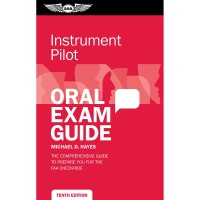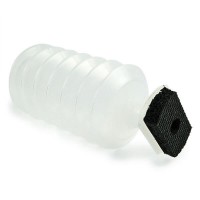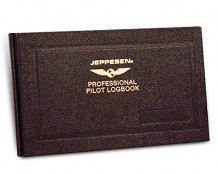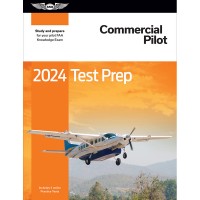ASA Test Prep 2024: Airline Transport Pilot & Flight Engineer
 Test Prep Plus Prepware
Test Prep Plus Prepware Prepware
PrepwareOverview
|
Includes: Softcover book, Airman Knowledge Testing Supplement CT-8080-7D, Prepware Download Edition, and FREE 24-month subscription to Prepware Online.
This bundle combines ASA’s popular Test Prep book and Prepware Download (code is included in the book) for the ultimate in flexibility and savings. Today’s hectic lifestyles demand efficient use of what limited study time is normally available. This bundle gives test applicants the convenience of choosing whichever test preparation method is most convenient at any given time or location. The Test Prep book is expertly organized into chapters based on subject matter and includes introductory text and illustrations, questions, answer choices, explanations (for correct and incorrect answers), answers, and references for further study. This topical study promotes better understanding and aids recall to provide a more efficient study guide. This bundle also includes the Airman Knowledge Testing Supplement—with the same FAA legends, figures, and full-color charts you’ll be issued at the testing center—to help you become familiar with all available information before you take your official test. Included with this bundle is ASA’s Prepware software download and 24-month subscription to Prepware Online. More than a “question and answer” recounting of test questions, it combines a powerful software program with the accurate and instructional material you expect from ASA. Prepware gives you the tools and confidence needed to ace the test. You can count on ASA to provide you with the latest changes in the FAA Knowledge Exams through a free email subscription service and updates. Use Test Prep Bundle: Airline Transport Pilot for the following Knowledge Exams:
|
Features
- Software replicates what you see when taking the official FAA exam
- Questions supported with explanations for correct and incorrect answers
- FAA references for further study identified in every explanation
- CX-3 electronic flight computer is built into the program and accessible with a click of a button.
- Review the questions you missed for an on-track learning program; performance graphs track your overall test scores and results in each subject
- Includes 24-month subscription to Prepware online, anywhere you have an internet connection
- Make and save notes while you study
- Google-like search functions locate a word, phrase, or airman test report code in the entire database of questions, answers, and explanations
- Create subject-specific pop quizzes or full-length practice exams to take electronically or on paper
- Download and automatically update the software so you’re always using the most current information available
- Free email subscription service keeps you informed of test changes
- Pass your test and know what is essential to become a safe, competent pilot—from the most trusted source in aviation training.
Specifications
- Edition: 2024
- Effective Date: 2023
- Page Count: 984
- Illustrations: Black and white, full color
- Inclusions: Softcover Book, Test Supplement, Software Redemption Code
- ISBN Number: 978-1-64425-337-3
- Dimensions: 8.25 x 10.75 inches
- Copyright: © 1957-2023 Aviation Supplies & Academics, Inc. All rights reserved.
- Date Published: 2024
- eBundle / eBook
- ASA eBooks are for one person's use and can be read on up to five devices total using e-reader applications that are compatible with an Adobe ID. To read eBooks on more than one device, the e-reader applications on those devices must be authorized with your Adobe ID.
- To create an Adobe ID, or to recover lost or forgotten ID information like your login or password, (Click Here)
Version Types
eBook PD - A protected document that looks identical to its print book counterpart. Exact formatting and layout of the print books is maintained (text, images, margins, page breaks, etc.). Displays best on 10-inch or larger screens. Not recommended for small screens (phones) which require you to zoom in and pan around to see the full page. This document is not a .pdf file type. It is a .acsm file type. See http://asa2fly.com/use-ebooks for more details on how to setup your device.
Softcover Book - Printed book with heavyweight cover stock.
eBook EB - A protected document designed for reflowable content. Also referred to as an ePub or "Electronic Publication" format. Easily viewed on both small and large screens. Text, images, and pages will adapt or reflow to fit the screen size of the device, so zooming is not necessary to read. Text size can be adjusted in an ebook reader app. Visit http://asa2fly.com/use-ebooks for more details on how to setup your device.
eBundle - Includes both the print book and eBook PD.
Reader Resources
New Codes Coming to Airman Test Reports
The FAA sample questions for the Private Pilot Airplane (PAR) and the Instrument Rating Airplane Airman Knowledge Tests now show two types of codes associated with each question:
- 1. The Learning Statement Code (LSC) associated with question topic areas. The Learning Statement codes currently appear on the Airman Knowledge Test Report for any missed knowledge test questions.
- 2. The “Airman Certification Standards” (ACS) code for question topic areas. The FAA expects the ACS codes to replace LSCs on the Private and Instrument Airman Knowledge Tests within the next 12 – 18 months.
For a detailed presentation and FAQs on the ACS (Click Here)
Airman Certification Standards
Since September 2011, the FAA has worked closely with a diverse group of aviation community stakeholders, including ASA, who convened to help the agency improve the testing/training standards, guidance, and test development/management components of the airman certification process. The industry participants in this effort have developed the Airman Certification Standards (ACS) framework as a way to improve airman training and testing by providing an integrated, holistic system that clearly aligns airman testing with certification standards and guidance. ACS is built on the existing Practical Test Standards (PTS), which explicitly define the performance metrics for each flight proficiency element listed in 14 CFR. The ACS approach enhances the PTS by defining the specific elements, aeronautical knowledge, and risk management awareness needed to support each Area of Operation and Task.
By presenting the elements of knowledge, skill, and risk management in the integrated ACS format, the ACS approach better serves the applicant, the instructor, and the evaluator. In addition, the ACS approach will enable the FAA to create and maintain a clear link between the regulations, knowledge/skill performance standards, guidance, and test materials.
The FAA has accepted the industry group’s recommendation to adopt the ACS approach and continues to work with this group to refine the ACS and plan for its eventual implementation. Current endeavors include FAA support for industry efforts to prototype the ACS approach in selected locations.
Airman Certification Standards (ACS) Codes
The overarching goal of the ACS effort is to create an integrated, coherent airman certification system in which standards, guidance, and testing can be aligned and maintained in alignment. This type of symmetry in all materials is key to fully realizing the benefits the ACS system promises to both the FAA and its many stakeholders. It is also the key to conformance with accepted industry standards for certification programs, which require that items to be trained and tested are directly linked to the job/task analysis—in this case, the ACS.
To help achieve this goal, the aviation community experts who developed the ACS have also created a new coding system that will eventually apply to both Airman Knowledge Tests and Practical Test tasks. These codes provide the means to correlate the tasks in the ACS with guidance and testing and to keep them aligned going forward. When the FAA implements the ACS approach, the ACS codes will supersede the current LSC system, which has become too limited to serve as a mechanism for alignment and too complex to effectively serve the needs of the FAA and the stakeholder community.
The proposed coding system has four elements that are anchored in the ACS and not in reference documents, as are the current LSCs. Examples:
PA . XI. A. K1
- PA = Identifies the applicable ACS (private pilot airplane)XI = Area of Operation (Night operation)A = Task (Night preparation)K1 = Task element [knowledge (K), skill (S), risk management (R)] (1. Physiological aspects of night flying as it relates to vision)
- IR = Identifies the applicable ACS (instrument rating)I = Area of Operation (Preflight preparation)A = Task (Pilot qualifications)K1 = Task element [knowledge (K), skill (S), risk management (R)] (1. When an instrument rating is required)
- Clearly align guidance and test questions to the ACS;
- Make the airman test report meaningful to stakeholders (applicant, instructor, evaluator);
- Provide a means for automated generation of tests, whether using the existing test forms or future randomized selections
- Eliminate subjectivity and vastly simplify system management requirements for the FAA.
Documents
System Requirements
- Does not install to mobile devices like an iPad or Android tablet.
- Windows and Macintosh compatible.
- Windows computers with Windows 10 are supported. Installation requires 300 MB hard drive space.
- Macintosh computers with OS X 10.9 or newer are supported. Installation requires 300 MB of hard drive space.
- 1024x768 minimum screen resolution, mouse or other compatible pointing device. PDF file reader for accessing supplemental support documentation. Product registration is required. Internet access is required for registration as well as program and test question updates. Once the program is installed and updated, internet is not required to run the program.
Q&A
Please note, Aircraft Spruce's personnel are not certified aircraft mechanics and can only provide general support and ideas, which should not be relied upon or implemented in lieu of consulting an A&P or other qualified technician. Aircraft Spruce assumes no responsibility or liability for any issue or problem which may arise from any repair, modification or other work done from this knowledge base. Any product eligibility information provided here is based on general application guides and we recommend always referring to your specific aircraft parts manual, the parts manufacturer or consulting with a qualified mechanic.








 FREE Shipping
FREE Shipping






















